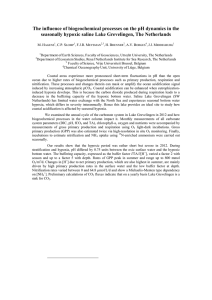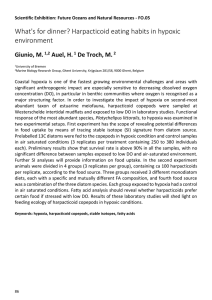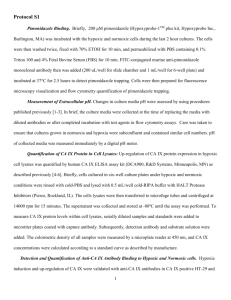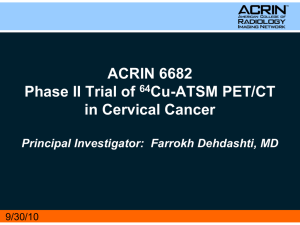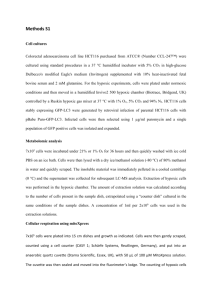Chemical Modification of Radiation Response
advertisement
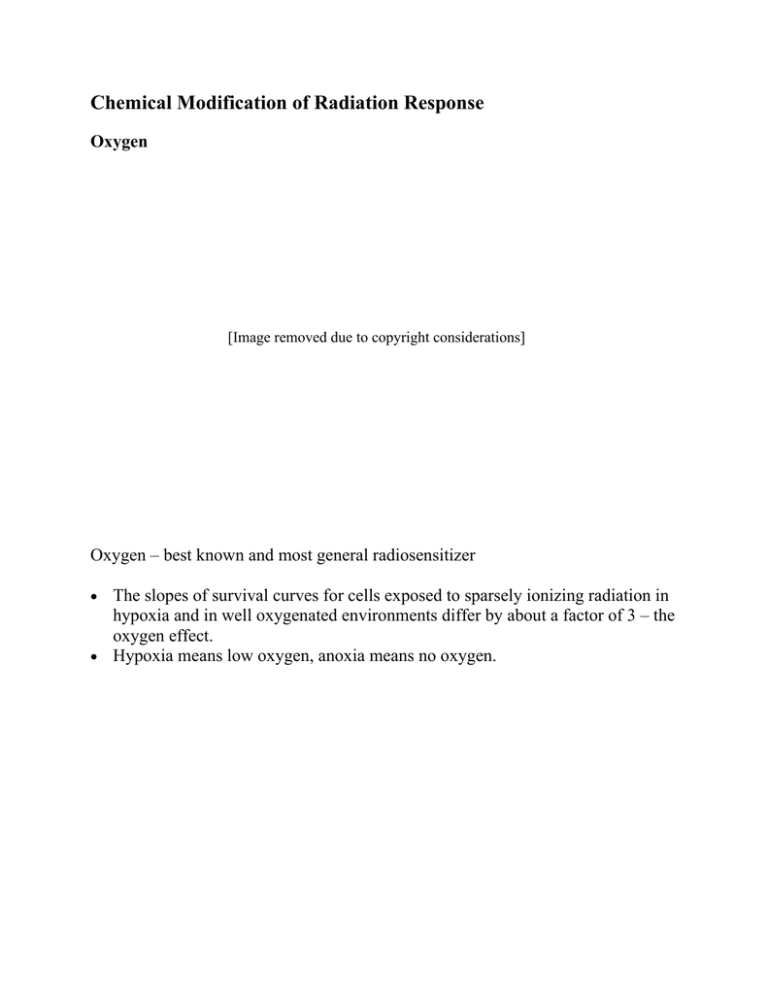
Chemical Modification of Radiation Response Oxygen [Image removed due to copyright considerations] Oxygen – best known and most general radiosensitizer • The slopes of survival curves for cells exposed to sparsely ionizing radiation in hypoxia and in well oxygenated environments differ by about a factor of 3 – the oxygen effect. • Hypoxia means low oxygen, anoxia means no oxygen. [Image removed due to copyright considerations] Oxygen Enhancement Ratio (OER) o D0(hypoxia)/D0(oxygenated) = dose(hypoxia)/dose(oxygenated) for the same effect • If the survival curves in both air and hypoxia extrapolate back to the same n value, the curves are said to be purely dose modifying. • OER is usually about 3 at high radiation doses, but often has a lower value of about 2 at low doses (at or below 2 Gy). How much O2 is required? Survival curves show that relatively little O2 is needed, e.g., as little as 100 ppm O2 (0.075 mm Hg) causes significant sensitization compared to the response in anoxia. [Image removed due to copyright considerations] “K-curve” – plot of relative radiosensitivity vs. oxygen concentration – shows halfmaximal effect of oxygen at about 0.5% (3 mm Hg) O2. (For comparison, venous p O2 is about 50 mm Hg and arterial is about 100 mm Hg; air is 155 Hg.) [Image removed due to copyright considerations] Timescale – When must O2 be present? • Very fast response techniques show that O2 must be present during irradiation or added within milliseconds after irradiation in order to be sensitizing. • For most practical purposes, it must be present during the radiation exposure. Mechanism • Mechanism(s) of the oxygen effect really not know, although, clearly, O2 acts at the free radical level. • The reactions involved may be: O2 + R⋅ → R O2⋅ O2 + e-aq → O2⋅- or • The later reaction is sometimes called “fixation” of damage in the lethal form and occurs in competition with chemical repair of damage, perhaps by H atom donation from thiols (to be discussed more below). Importance of the oxygen effect • • • • • Thomlinson and Gray (1955) studied sections of bronchial carcinoma Small tumors (<160 µ) – no necrosis Tumors over 200 µ - necrotic centers surrounded by sheath of healthy cells Sheath of growing cells always 100-180 µ They also calculated O2 diffusion in tissues and found that all O2 should be metabolized at a distance of 150-200 µ from a capillary, in good agreement with the observations of necrosis. • Actually, there will be an O2 concentration gradient through the tumor, so some tumor cells will have enough O2 to grow but will be radiobiologically hypoxic (and therefore radioresistant). These cells may limit the effectiveness of radiation therapy of tumors. [Image removed due to copyright considerations] This model is really a gross oversimplification of tumor oxygenation, but emphasizes the importance of oxygen in radiation therapy and explains why a great deal of research has been conducted into ways to overcome hypoxic cells. Hypoxic cells may be of two types: Diffusion-limited – as described by Thomlinson and Gray (chronic hypoxia) Perfusion-limited – cells intermittently [Image removed due to copyright considerations] hypoxic only when the blood flow transiently stops on their vessel (acute hypoxia). Dealing with the different types of hypoxia may require different methods. [Image removed due to copyright considerations] Do hypoxic cells really exist in tumors? The first demonstration that they do exist in an experimental animal tumor was made by Powers and Tolmach using the dilution assay technique. They observed a two component survival curve: Low doses – D0 = 1.1 Gy – normal high doses - D0 = 2.6 Gy The ratio of about 2.5 between to two D0 values suggested the OER: the low dose component was from oxygenated cells and the high dose component from hypoxic cells. Back-extrapolation of the high dose component to the y-axis gives the % hypoxic cells in the tumor. [insert hall 6.10] Hyperbaric Oxygen (HBO) Shortly after the identification of hypoxia as a potential cause of tumor radioresistance, clinical trials were begun with hyperbaric oxygen. Most trials have been relatively small and used unconventional fractionation patterns, but in several there was to be an advantage, albeit small, to the use of HBO. Problems included: - Questions of whether increases in dissolved O2 in plasma really resulted in increases in hypoxic tumor cells. - Some normal tissues may be of sufficiently low O2 to be sensitized by the HBO. - Practical problems such as patient convulsions due to oxygen, patient complications in lungs and ears, claustrophobia, danger of fire and explosion, etc. Use of carbogen (95% O2/5% C O2 at 1 atm) with or without perfluorochemicals may give as good or better results than HBO. Evidence for the presence of hypoxic cells in human tumors: Tumor histology Oxygen electrode measurements Clinical gains with hyperbaric oxygen Studies showing anemia is poor prognostic factor also associated with local failure, but pre-transfusion help. Radiation Sensitizers Radiosensitizers • Agents which enhance the response of cells to radiation. [Image removed due to copyright considerations] • Ideally, radiosensitizers would selectively sensitize tumor cells while having no effect on normal tissues. Non-hypoxic cell radiosensitizers • Halogenated pyrimidines, BUdR and IUdR • Are incorporated into DNa in place of thymine. Therefore, the tumor cells must be cycling faster than the nearby dose0limiting normal tissues. • IUdR and BUdR have similar sensitization with X-rays, but IUdR is preferable clinically because it sensitizes cells much less to fluorescent light, so less harmful side effects. • Sensitize both hypoxic and oxygenated cells. • The degree of sensitization depends on the amount of halogenated pyrimidine incorporated into a cell. • Clinical trials with IUdR are underway with gliomas and sarcomas with encouraging early results. The agent is being delivered with brachytherapy as well as external beam therapy. [Image removed due to copyright considerations] Hypoxic cell radiosensitizers [Image removed due to copyright considerations] Hypoxic cell radiosensitizers – electron-affinic compounds that selectively sensitize hypoxic cells while having no effect on oxygenated cells. Ideal properties of sensitizer: • Selectively sensitize hypoxic cells • Chemically stable and slowly metabolized • Highly soluble in water and lipids so can diffuse to hypoxic tumor cells • Effective throughout cell cycle • Effective at low daily doses of radiation SER = D0(without sensitizer)/D0(with sensitizer) Nitroimidazole class of compounds most studied. - Metronidazole (flagyl – a 5-nitroimidazole) gave in vitro SER = 1.7 and in vivo ER = 1.3. - Misonidazole (Ro-07-0582 – 2 – nitroimidazole) better sensitizer, with in vitro SER = 2.5 for hypoxic cells (no effect on oxygenated cells) and tumor SER up to 1.8. [Image removed due to copyright considerations] Hypoxic cell cytotoxins; Bioreductive agents (quinines, nitro compounds, benzotriazine di-N-oxides) - Drugs that are preferentially toxic to hypoxic cells. Agent Hypoxic Cell Cytotoxicity Ratio* Mitomycin C 2 EO9 5 Metronidazole 2 Misonidazole 11 Nitrofurazone 8.5 RSU 1069 67 SR4233 (tirapazamine) 50 * Drug dose required to kill given proportion of aerobic cells divided by that needed to kill same fraction of hypoxic cells Data all for V79 cells; HCR values vary with cell line • Killing hypoxic cells may have greater therapeutic advantage than radiosensitizing them because: • hypoxic cytotoxins kill cells resistant to radiation and most chemotherapy, producing complementary cytotoxicity. • random fluctuations in acute hypoxia could create a situation where hypoxia could be used to advantage. Modeling studies show that if a hypoxic cytotoxin is given with every dose fraction, the overall kill in a hypoxic tumor can be greater than if the tumor is fully oxygenated. This occurs when the drug kills at least 50% of the hypoxic cells each time it is given. However, for a hypoxic cytotoxin to be effective in a fractionated regimen, there must be rehypoxification between fractions. Results of clinical trials have been disappointing. Table 1. Results of randomized controlled trials of radiosensitizing methods Hyperbaric Metronidazole Misonidazole Oxygen Therapeutic Benefit 3 0 2 Significantly Improved Results 0 2 4 Margin in favor (not significant) 6 0 2 No Difference 6 4 30 Margin Against (not significant) 0 0 1 Adverse Response 0 0 0 15 6 39 (from Dische in Malaise et al 1989) Possible reasons for failure of misonidazole in clinical trials include: - Relatively small sample size and heterogeneous population may have precluded observation of a small effect. - SER may be lower at clinically relevant doses. - Misonidazole has cumulative neuropathy, which limited the dose that could be given and the number of fractions with which it could be given. (Total of 12 g/m2, so with single dose of 2 g/m2, which might be expected to give ER in hypoxic cells of about 1.3-1.4, could only give misonidazole with 6 fractions.) Radioprotectors [Image removed due to copyright considerations] Radioprotectors – agents which decrease the response of cells to radiation. Best radioprotectors are thiols Dose Reduction Factor (DFR) = Protection Factor (PF) = dose of radiation in the presence of the drug dose of radiation in the absence of the drug to produce a given level of effect. Proposed mechanisms for radioprotection by thiols: TH + ·OH → T· + H2O (TH = target) RSH + ·OH → RS· + H2O2 chemical protection The rate of the scavenging reaction is independent of the presence or absence of oxygen, so scavenging will not explain the differential protection by thiols in hypoxia and air. Donation of H atoms to organic radicals, in competition with damage “fixation” of those radicals by oxygen T· +RSH → TH + RS· chemical repair · damage fixation T + O2 → TO2⋅ Consumption of oxygen, so hypoxia is produced 2RSH + O2 → RSSR + H2O2 WR2721 (amifostime) and related compounds Covering the SH with a phosphate group decreased the toxicity In 1969 Yuhas and colleagues reported that WR2721 could protect normal tissues with less protection of tumors. [Image removed due to copyright considerations] Note that the degree of protection depends on the normal tissue type. [Image removed due to copyright considerations] However, radioprotection by WR2721 is not restricted to normal tissues; tumors can be protected. [Image removed due to copyright considerations] Some factors which affect the degree of radioprotection of normal tissue or tumor by WR2721 include: • Rate and extent of uptake of WR2721, which depends on: • Concentration of alkaline phosphatase in plasma membrane pH • Oxygen concentration • Endogenous thiol level • Fractionation pattern (single versus multiple doses) Clinical trials have shown side effects such as hypotension, nausea, vomiting, and hypocalcemia. Hypotension has been the dose limiting toxicity. • Only a few clinical trials with radiation have been undertaken. Although acute reactions to radiation appear to be protected, the effects on late radiation reactions remain to be evaluated in long term studies. Acute reactions do not always predict late reactions, so dose escalation must proceed cautiously. • Clinical trials suggest amifostine may be useful to protect against nephro-neuroand oto-toxicity from cis-platin treatment and cyclophosphamide-induced granulocytopenia. • More recently, interested in WR2721 and its derivatives has centered on observations that these drugs effectively protect against radiation-induced and some drug-induced mutations and neoplastic transformation. Protector WR-1065 WR-1065 WR-1065 WR-1065 WR-1065 WR-1065 WR-2721 Treatment Gamma rays Neutrons cis-PT HN2 BLM gamma rays gamma rays WR-2721 Mixture gamma rays X-rays Endpoint PF HGPRT mutations 5.1 HGPRT mutations 3.3 HGPRT mutations 7.1 HGPRT mutations 3.4 HGPRT mutations 2.8 Transformation 6.0 Preneoplastic 9.7 lesions Tumor induction 3.1 Tumor induction 1.4 From Grdina et al REFERENCES: E.J. Hall, Radiobiology for the Radiologist, 5th ed., Lippincott, Philadelphia, Chapters 6, 9 and 25. E.P. Malaise, M. Guichard and D.W. Siemann, Eds., Chemical Modifiers of Cancer Treatment, Pergamon Press, NY, 1989. T. Wasserman, D. Siemann and P. Workman, Eds., Chemical Modifiers of Cancer Treatment, Pergamon Press, NY, 1992. H. Bartelink and J. Overgaard, Eds. Radiotherapy and Oncology, Vol. 25, Suppl. 1, 1991. C.N. Coleman, Radiation and Chemotherapy Sensitizers and Protectors in Cancer Chemotherapy and Biotherapy, 2nd edition, Chabner and Longo, Eds., 553-584, 1996. J.M. Brown, The Hypoxic Cell: A Target for Selective Cancer therapy – Eighteenth Bruce F. Cain Memorial Award Lecture, Cancer Research, 59, 58635870, 1999. M. Werner-Wasik, Future Developments of Amifostine as a Radioprotectant, Seminars in Oncology, 26, 129-134, 1999.
